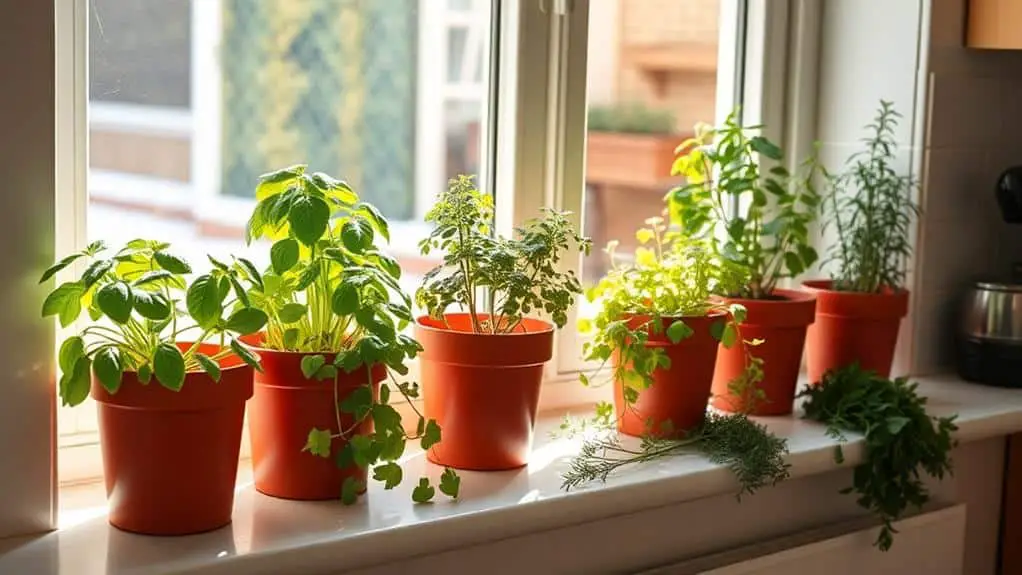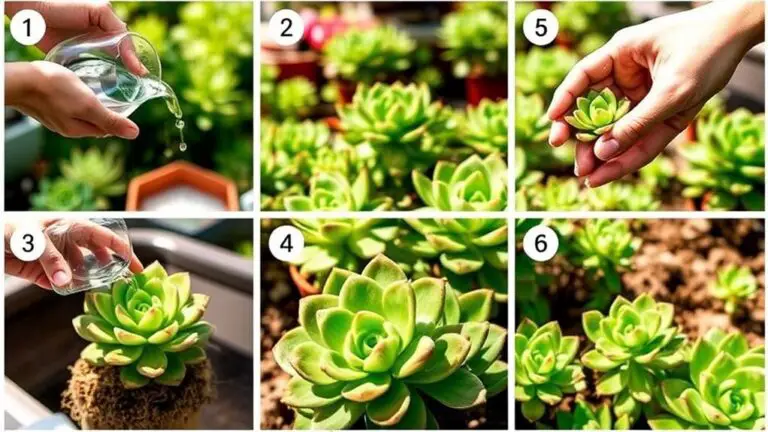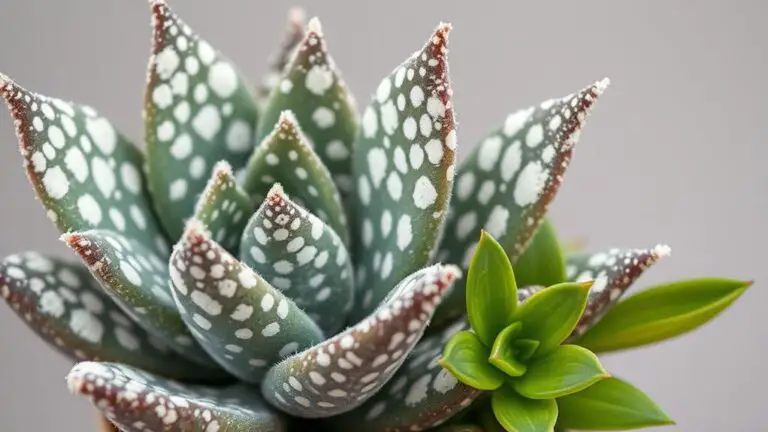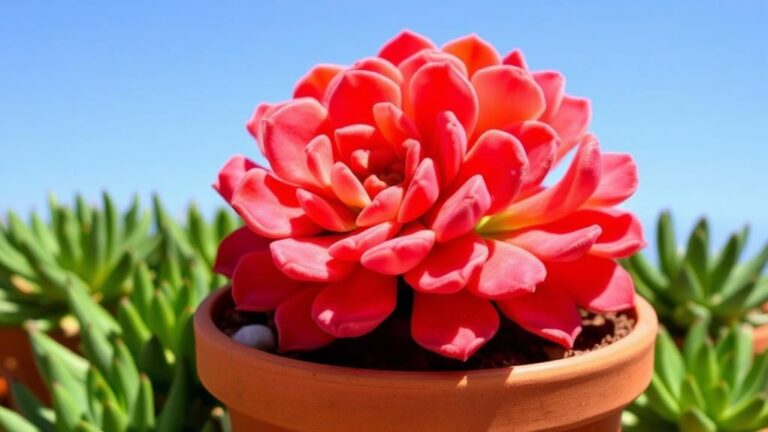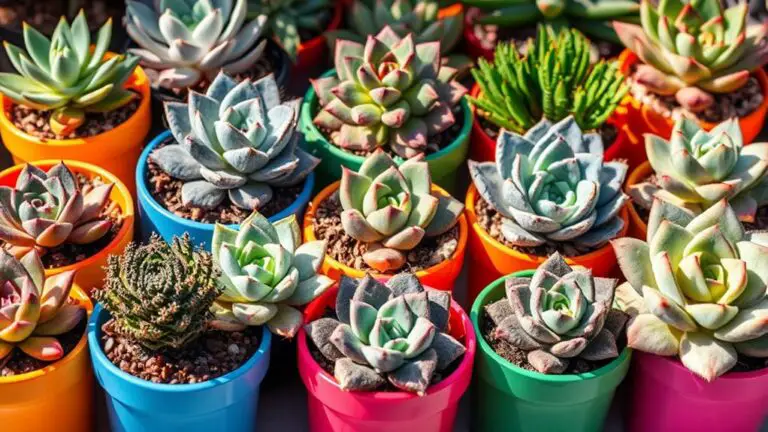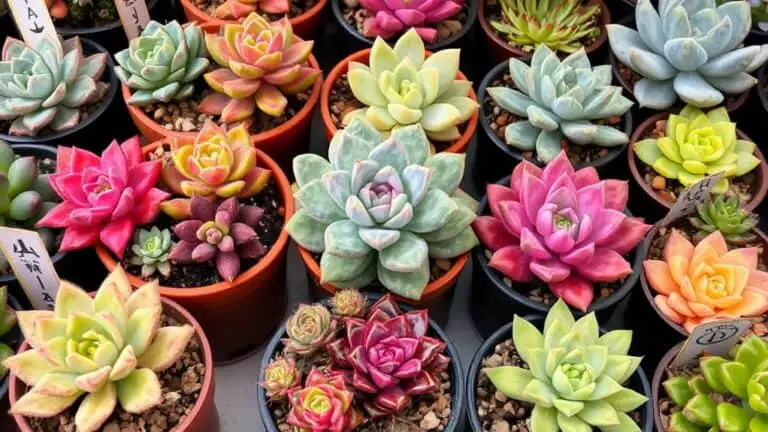10 Best Herbs to Grow Indoors for Fresh Flavors Year-Round
If you're looking to enhance your culinary creations with fresh, vibrant flavors year-round, growing herbs indoors is a fantastic option. Imagine having basil, chives, or cilantro readily available at your fingertips, no matter the season. Not only do these herbs thrive in well-draining soil and ample sunlight, but they also provide essential vitamins and antioxidants that promote a healthier diet. Curious about which other herbs make the top 10 list and how to guarantee they flourish in your indoor garden? Let's explore each herb and discover their unique benefits and care tips.
Basil
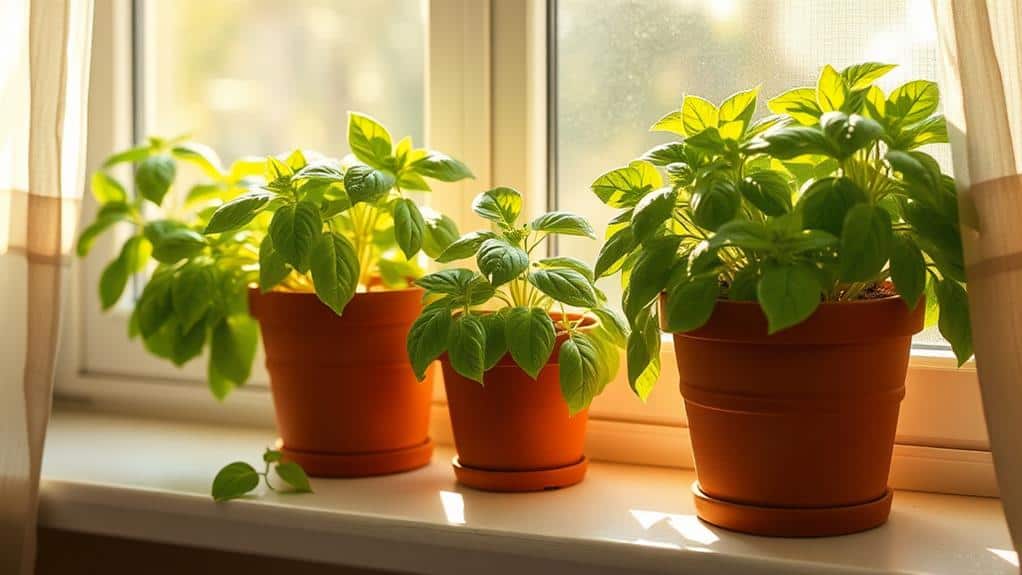
Growing basil indoors offers a fantastic way to enjoy fresh herbs year-round. You can grow herbs like basil in your home, ensuring you always have a supply of this flavorful, nutritious plant.
Basil thrives in warm conditions, ideally between 70-90°F. Make sure it gets full sun exposure for 6-8 hours daily to grow well. Place your basil near a sunny window or use a grow light if natural sunlight is limited.
Basil can grow to a mature height of 12 to 24 inches. Regular pruning is essential; it encourages bushier growth and prevents flowering, which can make the leaves bitter. Pinch off the top leaves regularly to promote continuous growth throughout the season.
This herb is rich in antioxidants and vitamins A, C, and K, making it a healthy addition to your meals. You can enhance the flavor of pasta dishes, salads, and other Mediterranean recipes with fresh basil leaves.
Plus, harvesting is simple—just pinch off the leaves from the top of the stems as needed.
Growing indoor herbs like basil is both rewarding and practical. With a little care, you can enjoy fresh, home-grown basil all year long.
Chives

Chives, with their mild onion flavor, are a versatile and easy-to-grow herb that can thrive indoors. To start your indoor herb garden with chives, you'll need a container with well-drained soil and a sunny spot. Chives love full sun, so place them near a south-facing window for the best results.
Chives typically reach a mature height of 12 to 18 inches, making them perfect for container gardening. Keep the soil consistently moist, but avoid overwatering. Regularly cutting the stems near the base encourages new growth, ensuring you can enjoy fresh chives year-round.
| Feature | Details | Tips |
|---|---|---|
| Height | 12 to 18 inches | Ideal for small spaces |
| Soil | Well-drained | Avoid waterlogging |
| Sun | Full sun | South-facing window best |
Chives enhance a variety of dishes like salads, soups, and garnishes with their subtle flavor. They're also rich in vitamins A and C and packed with antioxidants, making them a nutritious addition to your meals.
Growing chives indoors is not only practical but also rewarding. You'll have a constant supply of fresh herbs, adding both flavor and nutrition to your dishes. With minimal effort, your indoor herb garden can flourish, providing you with fresh chives all year long.
Cilantro
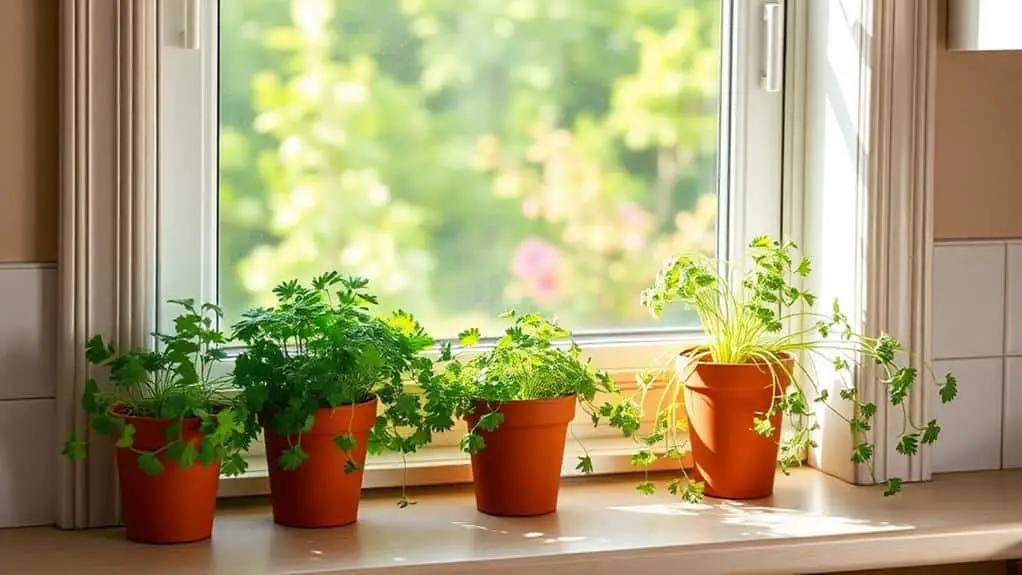
Cilantro is a fantastic herb to grow indoors, thriving in cooler temperatures between 60-70°F with plenty of sunlight or partial shade.
Make sure you plant it in well-draining soil and water it regularly to avoid heat stress, which can cause it to bolt.
You'll love using its delicate, citrusy flavor to enhance your favorite Mexican and Asian dishes like salsas, curries, and salads.
Growing Conditions
Cultivating cilantro indoors requires mindful attention to its preferred growing conditions. To start, cilantro thrives in cooler temperatures, ideally between 60-70°F, making it perfect for indoor growth during fall and winter.
When growing herbs indoors, you'll want to place cilantro in a spot where it can receive full sun to partial shade. Aim for at least 4-6 hours of direct sunlight each day to keep your cilantro healthy and vibrant.
Next, focus on the soil. Cilantro prefers well-draining soil that stays moist but not waterlogged. Make sure to let the top inch of the soil dry out between waterings. This helps prevent root rot and keeps your plant happy.
When it comes to watering, consistency is key, but avoid overdoing it.
Regular harvesting is also important. Cut the stems near the base to encourage new leaf production. This practice not only provides you with fresh cilantro but also prevents the plant from bolting when it gets too hot.
Culinary Uses
Incorporating cilantro into your culinary repertoire opens up a world of vibrant flavors and aromas. This versatile herb, known for its fresh, citrusy flavor, is a staple in Mexican, Indian, and Asian cuisines.
Whether you're making salsa, curries, or salads, cilantro can elevate your dishes with its unique taste. The leaves, often called cilantro, are best used fresh, while the seeds, known as coriander, are dried and ground to add a warm, nutty flavor to spice blends.
Using cilantro in your cooking isn't just about taste; it's also a nutritious addition, packed with vitamins A, C, and K.
Here are some delightful culinary uses for cilantro:
- Salsas and Guacamole: Finely chop cilantro and mix it into your favorite salsa or guacamole for a burst of fresh flavor.
- Curries and Soups: Add cilantro leaves at the end of cooking to retain their bright flavors and scents.
- Salads and Dressings: Sprinkle fresh cilantro on salads or blend it into dressings for a zesty twist.
Dill
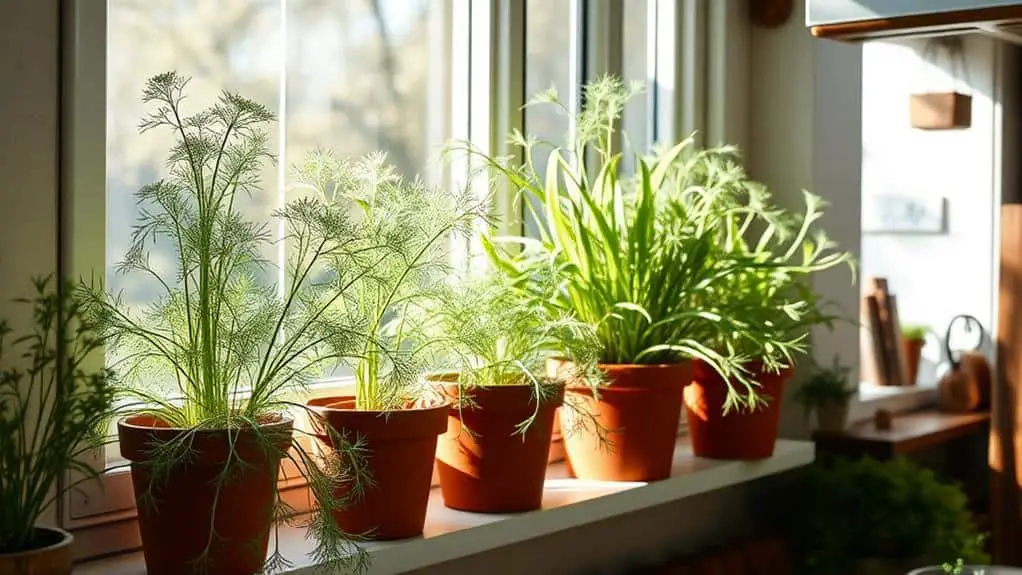
Growing dill indoors can be very rewarding with the right care and maintenance. This herb needs plenty of sunlight and well-drained soil, so place it near a sunny window and stake it if it gets too tall.
Harvest dill by snipping the outer stems regularly to keep it producing fresh, flavorful leaves perfect for pickling and seasoning your favorite dishes.
Care and Maintenance Tips
When it comes to caring for dill indoors, providing it with full sun for 6-8 hours daily is essential for healthy growth.
Position your dill in a sunny window or under a grow light to make sure it gets enough light. Dill loves well-drained, nutrient-rich soil, so use a good quality potting mix.
Regular watering is key, but don't overdo it. Let the soil dry out slightly between waterings to avoid root rot. A good rule of thumb is to water when the top inch of soil feels dry.
To encourage new growth and keep your dill bushy, snip the outer stems while allowing the inner growth to continue. This will promote a steady supply of fresh herbs for your kitchen.
If you want your dill to thrive, keep these care and maintenance tips in mind:
- Use well-drained, nutrient-rich soil.
- Water regularly, letting soil dry slightly between waterings.
- Snip outer stems to encourage bushier growth.
Dill can grow up to 24 inches tall, so make sure it has plenty of vertical space.
With these tips, you'll have a lush, flavorful herb ready to enhance your dishes year-round.
Harvesting Dill Successfully
Harvesting dill successfully involves a few essential steps to guarantee you get the most flavorful and aromatic leaves.
First, make certain your dill is getting enough sunlight. Dill thrives in full sun, so aim for 6-8 hours of sunlight daily. This helps the plant grow strong and produce those tasty leaves you're after.
When it's time to harvest, focus on the outer stems. Snip these at the base. This method allows the inner stems to keep growing, making your dill bushier and more productive.
It's best to harvest before the plant flowers. If you wait too long, the leaves can lose some of their flavor and aroma.
Dill can grow up to 24 inches tall, so don't be afraid to trim it regularly. Using fresh dill is ideal, but if you have more than you need, you can dry the excess. Store dried dill in airtight containers to keep its flavor intact.
Growing herbs like dill indoors is a rewarding experience. By following these simple steps, you'll guarantee a continuous supply of fresh, flavorful dill year-round.
Culinary Uses and Benefits
Dill, with its distinct and tangy flavor, effortlessly elevates a variety of dishes, making it a versatile herb in any kitchen. You can use it to season fish, enhance sauces, or even add a unique touch to pickling. Dill's culinary uses are endless, making it a must-have for your indoor herb garden.
To enjoy its full potential, make sure your dill grows in well-drained soil and gets plenty of sunlight. This herb thrives in full sun, needing 6-8 hours of light daily to grow strong and healthy. Regularly harvesting the outer stems encourages inner growth, giving you a continuous supply.
The health benefits of dill are just as impressive as its flavor. Its feathery leaves are packed with antioxidants, which help reduce inflammation and aid digestion. Adding dill to your diet can be both delicious and beneficial.
Here are some ideas to get you started:
- Pair dill with potatoes: Its fresh, tangy taste complements the earthy flavor of potatoes perfectly.
- Yogurt-based sauces: Dill is essential in dishes like tzatziki, adding a revitalizing twist.
- Creamy dressings: It's a key ingredient in many creamy dressings, bringing a burst of flavor.
Grow dill indoors, and you'll always have fresh flavors at your fingertips!
Mint
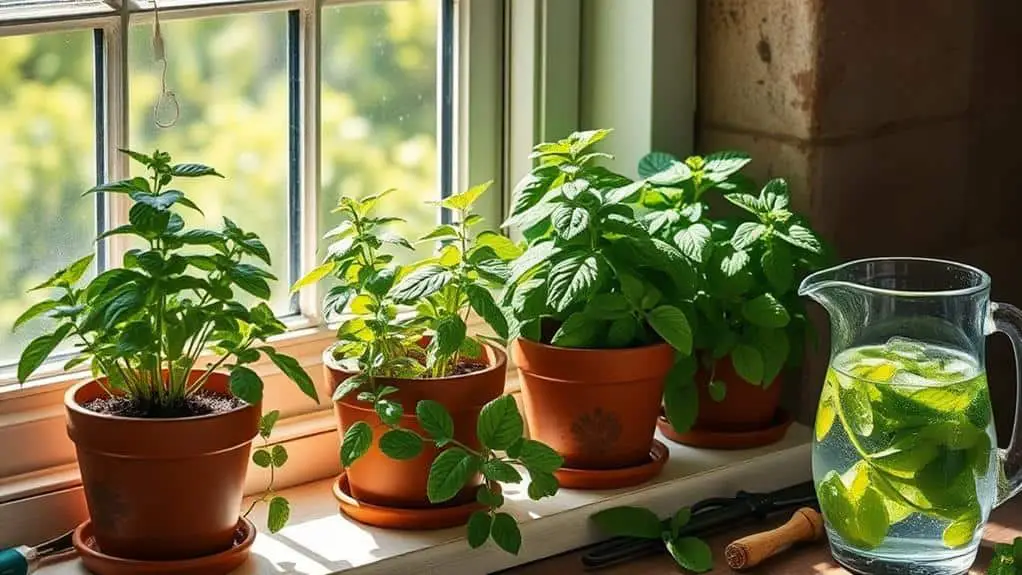
Mint (Mentha spp.) is an incredibly versatile herb that's perfect for indoor gardening. It's a fast-growing plant that prefers partial shade but can tolerate full sun, making it adaptable for any indoor space. When you grow mint indoors, aim for a spot with plenty of indirect light to keep it happy.
Mint typically reaches a mature height of 12 to 24 inches. To help it thrive, plant it in well-drained, moist soil. This herb's invigorating flavor makes it a favorite for teas, desserts, and savory dishes. Plus, growing it indoors means you'll have fresh mint at your fingertips year-round.
One thing to remember is that mint can be a vigorous grower. It can quickly become invasive if not contained, so it's best to grow it in pots. This way, you can manage its spread more easily.
To keep your mint plant healthy and flavorful, regularly harvest the leaves. This promotes bushier growth and enhances the flavor profile. For the best taste, try harvesting the leaves in the morning.
Indoor gardening with mint is a rewarding experience. It's easy to grow and provides a continuous supply of fresh, aromatic leaves for your culinary adventures.
Oregano
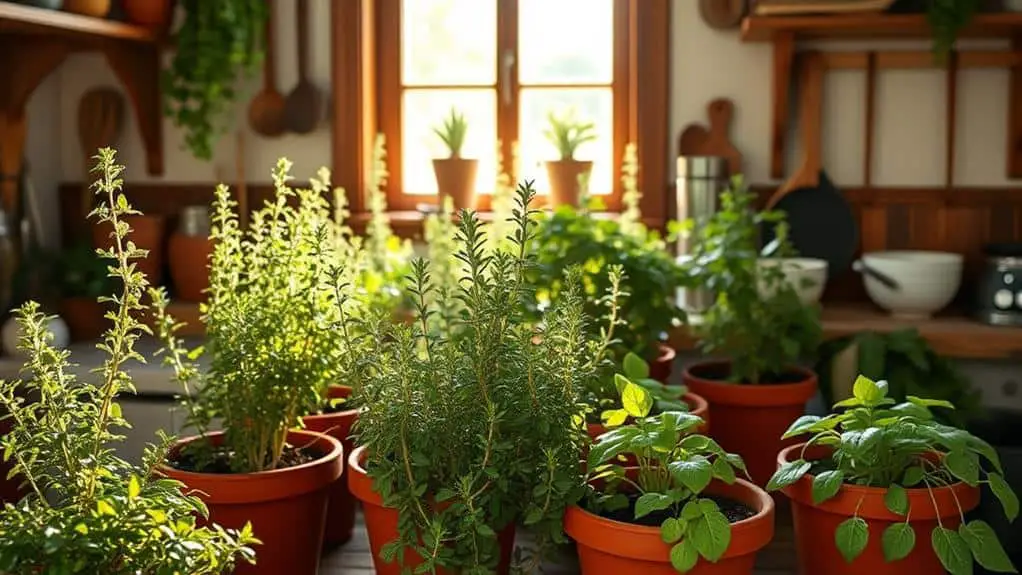
Oregano is a fantastic herb to grow indoors because it's easy to care for and packs a punch in the kitchen.
Make sure it gets plenty of sunlight, around 6 to 8 hours a day, and plant it in well-draining soil to keep it happy.
Regularly pinch off the leaves for your favorite dishes like pizza and pasta, and enjoy the extra health benefits it brings.
Care and Growth Tips
When growing oregano indoors, guaranteeing it gets at least 6-8 hours of full sun exposure daily is essential for ideal growth. If you don't have a sunny window, consider using a grow light to provide the necessary light.
Oregano thrives in well-draining soil and prefers to dry out between waterings, which makes it easy to care for.
To keep your oregano happy and healthy, make sure to:
- Water wisely: Allow the soil to dry out between waterings to prevent root rot.
- Prune regularly: Pruning encourages bushier growth and guarantees a steady supply of fresh leaves.
- Provide good drainage: Use a pot with drainage holes to avoid waterlogged soil.
Place your oregano plant in a sunny window or under a grow light to mimic its natural environment. Oregano typically reaches 8 to 12 inches in height, so it won't take up much space.
When harvesting, pinch off the leaves or cut the stems without damaging the woody branches. Regular pruning not only keeps your plant looking neat but also stimulates new growth, guaranteeing you have fresh oregano year-round.
With just a little care, you'll enjoy this fragrant herb in your indoor garden.
Culinary and Health Benefits
Elevate your culinary creations and boost your health with oregano, a powerhouse herb that's easy to grow indoors. Oregano is rich in antioxidants and boasts anti-inflammatory properties, making it a healthy addition to any meal. It's a staple in Mediterranean cuisine, enhancing the flavors of pasta, pizza, and various sauces. Imagine the burst of fresh oregano in your dishes, elevating them to new heights.
Growing oregano indoors is straightforward. It thrives in well-draining soil and needs minimal watering, making it perfect for year-round cultivation. This means you can always have fresh oregano at your fingertips, ready to add a burst of flavor to your culinary masterpieces.
But oregano isn't just about taste. Its essential oil contains compounds like carvacrol and thymol, which have potential antibacterial and antifungal effects. Regularly using fresh oregano can contribute to your overall health, thanks to its vitamins A, C, and K.
Whether you're an experienced gardener or just starting, oregano is one of the best herbs to grow indoors. It's easy to care for and provides incredible culinary and health benefits, making it a fantastic addition to your indoor garden.
Parsley
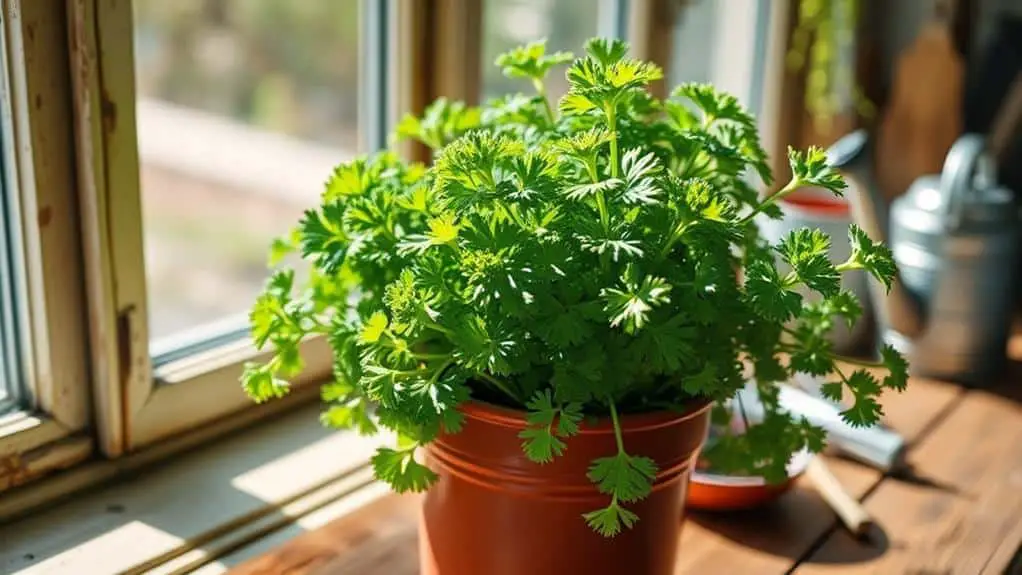
Parsley (Petroselinum crispum), thriving in well-drained soil with partial to full sunlight, is an excellent herb to grow indoors.
It's a fantastic choice for your windowsill herb garden. Not only is parsley ideal for growing indoors year-round, but it also provides fresh flavors to enhance your meals.
This herb can grow up to 12 to 18 inches tall and prefers moist soil. It's highly versatile in the kitchen, commonly used as a garnish and flavoring in various dishes.
Parsley is packed with vitamins A, C, K, and iron, making it a nutritious addition to your diet. Regularly harvesting parsley involves cutting the outer stems from the base. This method encourages new growth and keeps your plant productive for longer periods.
Some tips to guarantee your parsley thrives indoors include:
- Light: Place your parsley in a spot with partial to full sunlight, such as a sunny windowsill.
- Watering: Keep the soil consistently moist but not waterlogged.
- Harvesting: Regularly trim the outer stems to promote continuous growth.
Rosemary
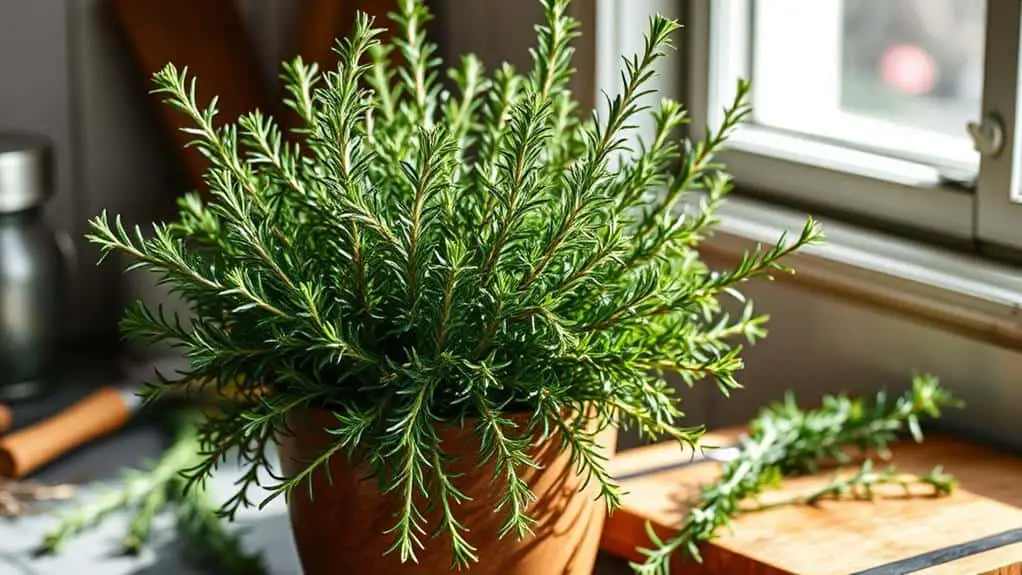
Switching gears from parsley, let's talk about another excellent herb to grow indoors—rosemary. This hardy Mediterranean herb thrives in full sun, needing 6-8 hours of direct light daily. So, place your rosemary pot in a sunny spot in your garden or by a bright window.
It prefers well-draining soil to avoid root rot, which guarantees a healthy plant. Rosemary can reach a mature height of 12 to 24 inches, making it a manageable size for indoor gardeners. Its drought-resistant nature means you won't need to water it frequently, making it low-maintenance.
To promote bushier growth, regular pruning is essential. Snipping rosemary stems not only enhances its aromatic flavor but also keeps the plant looking lush. When it comes to harvesting, just snip off sprigs as needed. This way, you allow the base to continue growing, ensuring a continuous supply of fresh rosemary.
This herb isn't only flavorful, perfect for Mediterranean dishes, but it's also rich in antioxidants and has anti-inflammatory properties. So, by growing rosemary, you're adding both taste and health benefits to your meals. Happy gardening!
Sage

Although rosemary is a fantastic choice for indoor gardening, sage presents another excellent option.
Sage (Salvia officinalis) is a hardy herb that thrives indoors with minimal care. It typically grows to a height of 12 to 24 inches and loves full sun. So, place it near a sunny window to keep it happy.
Sage prefers well-drained soil, so verify your pot has good drainage and water it only when the soil feels dry.
This drought-tolerant herb has a distinctive earthy flavor, making it perfect for Mediterranean dishes, especially poultry and stuffing. Sage leaves aren't just tasty; they also contain antioxidants and anti-inflammatory properties, adding a health boost to your meals.
To guarantee your sage plant stays bushy and doesn't become leggy, remember to prune it regularly. Snip the top leaves, and your plant will grow more vigorously. This simple task helps keep your sage looking its best.
Here are some quick tips to help you succeed:
- Full Sun: Place your sage in a sunny spot.
- Well-Drained Soil: Verify your pot has drainage holes.
- Prune Regularly: Trim the top leaves for bushier growth.
With these tips, you'll enjoy fresh sage year-round!
Tarragon
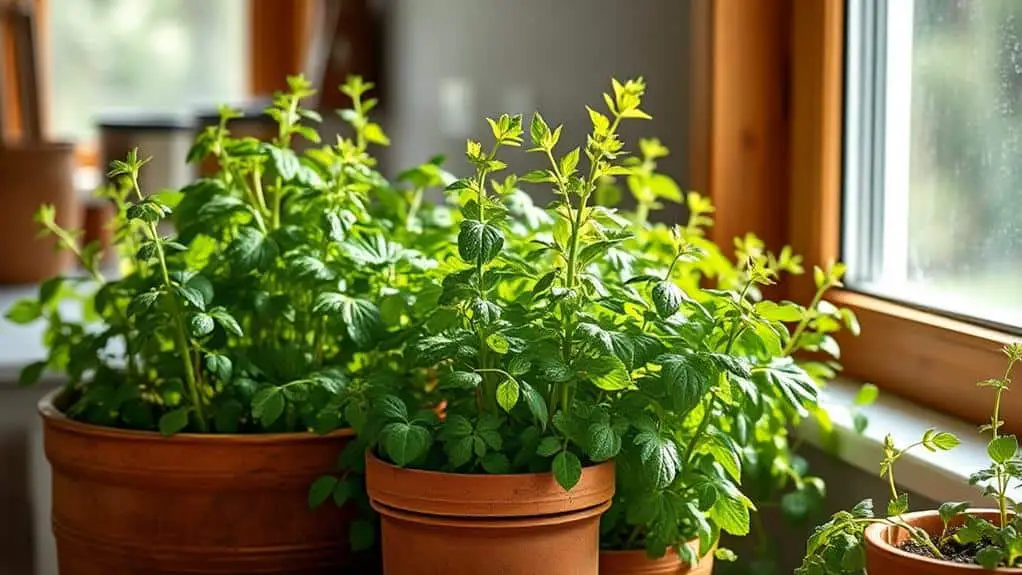
Tarragon (Artemisia dracunculus) adds a unique, anise-like flavor to your indoor herb garden, making it a standout choice for culinary enthusiasts. Known for its role in French cuisine, especially in sauces and dressings, tarragon is one of the best herbs you can grow indoors.
To thrive, tarragon needs plenty of hours of sun, ideally in a south-facing window. Make sure it gets full sun and well-drained soil to grow strong and healthy. Warmer temperatures between 70°F and 80°F are perfect for it, and it can grow up to 18 inches tall.
Remember, regular harvesting by pinching off leaves or cutting stems helps it stay lush and flavorful.
Tarragon requires a dormant period for ideal growth. As the weather cools in the fall, find a spot with less light to let it rest. This will help it bounce back even stronger when it's time to grow again.
Plus, tarragon isn't just tasty; it's also good for you. It contains antioxidants and supports digestion, making it a beneficial addition to your diet.
With these tips, you'll confidently grow fresh tarragon year-round, enjoying its delightful flavor in your favorite dishes.
Frequently Asked Questions
What Herbs Can You Grow Indoors Year Round?
You can grow herbs like basil, chives, cilantro, oregano, parsley, rosemary, thyme, and mint indoors year-round. These herbs thrive with proper care, providing fresh flavors for your dishes continuously. Just guarantee they get sufficient light and water.
What Culinary Herbs Can You Grow Indoors?
You can grow culinary herbs like basil, chives, cilantro, oregano, and parsley indoors. They each have specific light and temperature needs, but they'll enhance your dishes year-round with their fresh flavors.
How Do You Keep Herbs Fresh Year Round?
Regularly snip leaves or stems to encourage growth. Store harvested herbs in a glass of water in the fridge, covered with a plastic bag. Dry excess herbs or freeze chopped herbs in ice cube trays to preserve freshness.
What Herbs Are Good for Kitchen Windowsill?
You'll find basil, chives, and parsley thrive on sunny kitchen windowsills, needing 6-8 hours of sunlight. Mint adapts well to partial shade, while rosemary and thyme prefer well-drained soil. Cilantro likes cooler spots with indirect light.
Conclusion
You've got everything you need to start growing herbs indoors! With a bit of sunlight and care, you'll enjoy fresh basil, chives, cilantro, and more all year long. Don't worry if you're new to gardening—everyone starts somewhere. Just remember to water them, give them enough light, and use well-draining soil. Soon, you'll be adding delicious, healthy flavors to your meals straight from your own mini garden. You can do this! Happy gardening!

